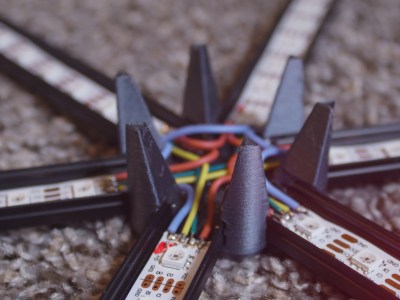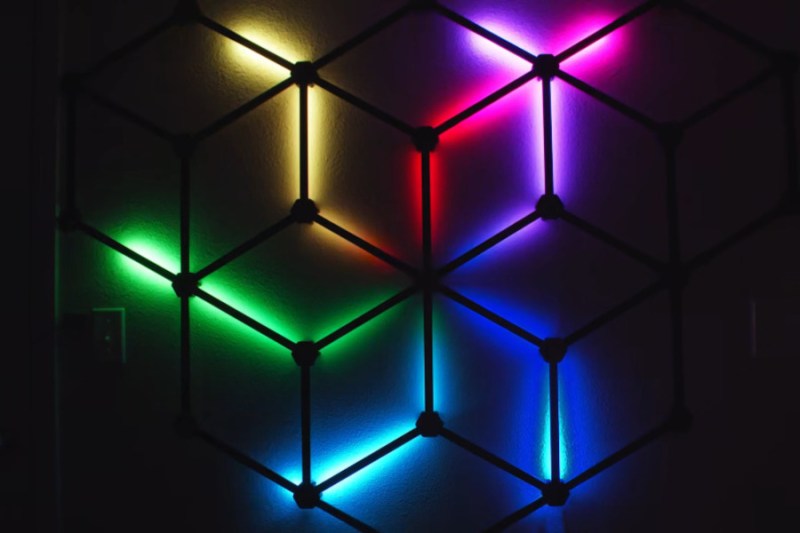Great news for fans of [Voidstar Labs] — [Zack] is going to be streaming future builds live on YouTube instead of trying to keep up with a grueling and limiting schedule of releasing a build video every week. The only problem is that the wall behind him is totally blank and boring, which matters quite a bit for pretty much any streamer that doesn’t broadcast from a hot tub. Well, not anymore! Now the wall has twenty square feet of rainbow hexagons, because blinkenlights.
 But these aren’t just any blinkenlights. They’re informative. They dance to the beat of [Zack]’s bio-metrics, or in other words, they are visualizing how sweaty and anxious [Zack] may be at a given moment, and turning that information into art.
But these aren’t just any blinkenlights. They’re informative. They dance to the beat of [Zack]’s bio-metrics, or in other words, they are visualizing how sweaty and anxious [Zack] may be at a given moment, and turning that information into art.
At the heart of this build is a brand-new bio-metric board called the EmotiBit which boasts sixteen sensors in a small package, including a pulse oximeter. The EmotiBit sends vitals to [Zack]’s PC, which is running an oscilloscope app to interpret the signals. Then they are sent over Open Sound Control to an ESP32, which runs the light show.
Like [Zack] says in the video after the break, this isn’t a terribly difficult project, but the construction takes time. [Zack] used aluminum extrusion meant for under-cabinet lighting and ran forty strips of fourteen DotStar LEDs each. The nodes are printed in carbon-fiber PLA and hold the lights away from the wall so it looks cooler. Worried about the current draw? It’s okay, because the brightness and number of lit LEDs at any one time is limited. Add in the fact that none of the LEDs are ever turned off — they fade by one percent each loop — and you have some really cool animations. Check them out after the break.
Want some localized blinkenlights to wear about town? Wear your heart on your sleeve and show them how hard you’re crushing the elliptical at the gym.
















Lots of flack from the peanut gallery on a really awesome project that’s documented pretty nicely for anyone who wishes to replicate it. Does Hackaday not like these things now or are we all just grumpy today?
There’s a group of commenters who are here *only* to race to find something to bitch about, whether it be trivial typos or someone using the “wrong” device or why isn’t the Pico a clone of the esp32/stm32/555?
I also think the HaD staff are getting a bit more fed up with it of late and are reaching for the delete button more than they used to, given that none of that flack you’re talking about is present now.
One of the neatest, and best presented projects we have seen here for a while. Really want to know what the grumps were getting their knickers in a twist over now… Shame I missed it, but I don’t blame HaD for clearing out the troll bile.
About all I can see to complain about is its a pretty simple project conceptually and in execution, so perhaps the ‘not a hack’ chorus but for me that isn’t a bad thing, infact when the results are satisfactory that is a good thing! Sure building your own CPU from discreet components to run the code to then drive the individual colour led in a beautiful brass dead bug style circuit sculpture is more impressive, but that doesn’t actually make it better.
Seems I arrived a bit late to see the now deleted comments.
but may I mention the this incessant penchant for having every single freaking background writhing like something that a meth addled Capuchin designed, gets a bit old when you are cursed by migraine headaches.
Every damned TV channel now seems to feel the need to inflict this video spasm on us now…..
A real treat to try watching the weather guesstimate, while the screen looks like a bad/”Brown” acid trip or whatever the heck it’s supposed to be, is always roiling around underneath what used to be a weather report.
Could we just please give the visual clutter a rest finally??